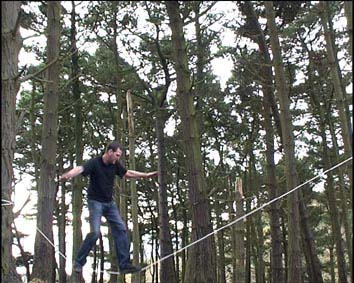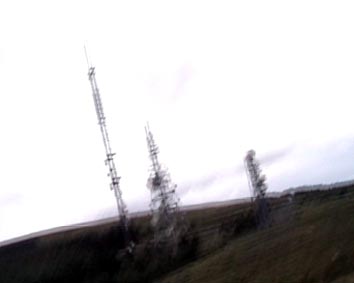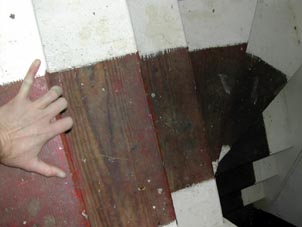| |
| Brian Duggan: 104 stairs; (17.04), digital video export; courtesy the artist |
Once when I was in college a lecturer asked me if I had made up my name. He considered it such a brilliant confection of ordinariness that it must have been a clever and ironic comment on the constructed and lacklustre nature of contemporary identity. It couldn’t possibly be a real name. (I was sorry to disappoint.) This episode came to mind when viewing Brian Duggan’s recent exhibition at Pallas Heights, which makes comparable adventures into the banal territories of everyday life and how to orientate ourselves in our immediate mental and physical environments.
I found myself identifying with the decidedly ordinary protagonist (the artist) who performs a number of tasks and self-imposed challenges. He seems familiar but anonymous enough. He replaces the ‘man in the white suit’ of previous work [1], ironically becoming less of a ‘personality’ rather than more so. His uniform varies but revolves around a casual capsule wardrobe of blacks, navys and greys, jeans, simple tops and standard runners. Without meaning to offend, there really is very little remarkable about him at all – white male, not overly fat or thin, brownish hair, medium weight, no obvious distinguishing features.
Likewise, the work is pared down to a handful of simple elements: 1. the body (the artist); 2. the location; 3. the rules / task (self-determined and faithfully followed); 4. the witness – a video camera. The installation in the space is similarly spare and encourages a comparable economy of experience.
 |
| Brian Duggan: 2.01 seconds tightrope; (1.48), digital Video Export; courtesy the artist |
Our hero is not in the least acrobatic, skilled or stylish. There are no macho feats for the camera. There are none of the feigned theatrics of reality-TV show challenges ( Fear factor, I’m a celebrity… ) The tasks are serious if sometimes carried out with an appreciation of the slapstick. He is trapped in a doorframe (upside-down); falls off a makeshift tightrope; progresses up a stairs on his hands; performs 71 jumps (and edits the piece to show only the airborne portion of the adventure). The whole ordeal sometimes seems an exercise in pointless, exhausting, comic effort.
The locations in the videos are like the main character in that they share similar paradoxical qualities of particularity and vagueness. The work made on the stairs of the flats, the camera picking up on a rich territory of patterned lino, painted boards, white walls and the occasional glimpse of a discarded biro, provides both an intimate portrait of a particular place, and is exhibited within it. Yet it also provides a jumping off point to remember or imagine countless other similar places. It’s the same with the other locations – the Dublin mountains, the Burren in Co. Clare, and other sites around the city: they each have their particular resonances: they are all familiar but ultimately elusive. The location where the video is shot is treated as a backdrop to enact certain personal tests, with self-determined and sometimes obscure rules. This drama is carried in the mind/ body of the artist as events play out again and again and again.
It would be a mistake to think that our hero is isolated in his psychological intensity, absorbed in his strenuous, challenging and often futile tasks. There is an attempt to involve the viewer in the work, gentle but insistent gestures that aim for participation rather than spectatorship. The work is installed in a variety of ways, using projections and monitors with various conflicts of scale and location – works are presented on a stairwell and wardrobe as well as more conventional projection-room formats.
 |
| Brian Duggan: More often than most installation shot; courtesy the artist |
The use of the space is intimate and involving, and the works evoke a dialogue between themselves that includes the person in the room with them. This is achieved through the use of simple devices such as works being installed at different levels and at different scales – for example Stresshead, a small LCD screen with a close-up of the artist’s eyes while performing a handstand, that is inserted into the wall just above eye level. In some cases the artist has made incisions into the building to position monitors or cut a hole in a wall to project through – which further causes the viewer to bend over, to stretch up or stand awkwardly on one step to see the work.
Most prominent among these ‘viewing’ triggers are the swings installed in various rooms (the artist providing the viewer more comfort than he has afforded himself). This at once involves the ‘viewer’ in a physical as well as a mental capacity and perhaps aims to subtly needle the viewer-body into some kind of awareness of their actual, perhaps passive, physical state.
 |
| Brian Duggan: 36 Seconds; (71 jumps) (1.33), digital video export; courtesy the artist |
It is easy to empathise with the trials of this ordinary man, that are curiously sometimes quite touching in their regular goals, and achievements. This ultimately makes for an accessible body of work (accessible in the best sense) that is gentle in its times of mild desperation, and tinged with sadness in its slapstick.
It is difficult when looking at the work not to associate it with the space from which it ultimately came, the constantly changing territory of Pallas Studios and Pallas Heights. This block of flats, earmarked for demolition for the past two years, has consistently been given stays of execution (the final date for demolition is set for early 2006). Obviously such a situation necessitates a constant imperative to develop ways of adapting to new spatial, social, financial and bureaucratic pressures.
 |
| Brian Duggan: 104 stairs; (17.04), digital video export; courtesy the artist |
Such a way of operating evokes Michel de Certeau’s idea of the tactic :
It takes advantage of opportunities and depends on them, being without any base where it could stockpile its winnings, build up its own position, plan raids. What it wins it cannot keep. This nowhere gives a tactic mobility to be sure, but a mobility that must accept the chance offerings of the moment… [2]
Such situations do not lead to the orchestration of grand, theatrical one-off projects, but rather a body of work such as Duggan’s, that operates on a modest scale, building incrementally over time into something substantial, if more provisional than permanent or fixed in character.
Sarah Browne is an artist currently based in Co. Leitrim, Ireland.
[1] Brian Duggan, During the meanwhile, IFSC/ Dublin City Hugh Lane Gallery, January – February 2005
[2] Michel de Certeau, The Practice of Everyday Life, University of California Press, Los Angeles, 1984, p. 37